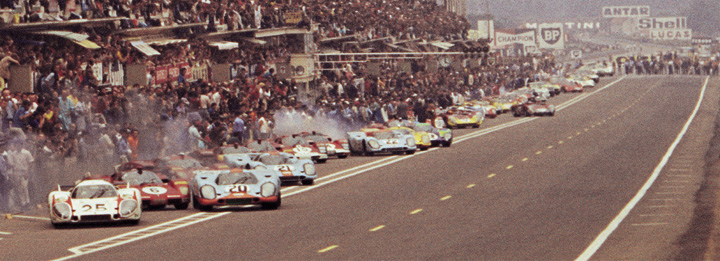
The start of the 1970 24 Hours of Le Mans. Picture source: autotrend.com
One of the most significant and recognizable race cars of all time is the Porsche 917. Not only was the 917 the car that brought Porsche it’s first overall win at Le Mans, but it was made famous by Steve McQueen who piloted one in the movie “Le Mans”.

1971 “Le Mans” movie poster. Source: IMDB
There are countless articles, posts, books, and movies about the 917 and “Le Mans”, so no need to continue summarizing the highlights. However, certain details are still fascinating to discuss, especially 917 chassis numbers. Specifically the chassis numbers that raced at the 1970 24 Hours of Le Mans and those on set during the making of the 1971 film “Le Mans”.
While Steve McQueen and the movie “Le Mans” can be linked to several 917 chassis, it’s not always clear which chassis ran the race vs. which was filmed only for the movie. This is because some of the racing scenes in the movie are of the actual race and they copied those race liveries to different 917 chassis for filming “Le Mans”. So just because it looks like Steve McQueen’s 917 in a Gulf Oil livery, it doesn’t necessarily mean you’re looking at one he drove or even one that was on the movie set. For example, the Porsche Museum has displayed 917-001 in the 1970 Le Mans winning red and white Salzburg No. 23 livery for years, but 917-001 never ran this livery in racing history. It was 917-023 that won the 1970 24 Hours of Le Mans in that livery. Displaying a chassis in a different livery is not unusual, but usually the details of the livery vs. chassis are absent from signage or articles.
Hopefully this article can be used as a reference for current and future 917 enthusiasts. However, it will only scratch the surface on overall 917 chassis history and have limited yet focused history of each particular chassis mentioned below. By the end you will know which Gulf Oil liveried 917s participated in the 1970 24 Hours of Le Mans vs. which were used in the making of the 1971 film “Le Mans” and how to identify specific cars in the movie!
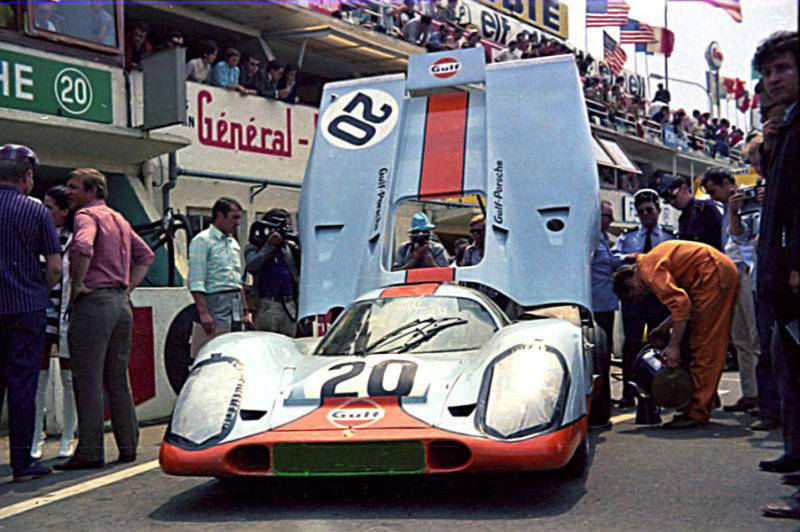
917-017/004 in the pits before the start of the 1970 24 Hours of Le Mans. Picture credit: Michel Guilloux
The Race
In the 1970 24 Hours of Le Mans there were a total of EIGHT Porsche 917s entered. Porsche’s main competition was the ELEVEN Ferrari 512 S… Clearly a different approach to racing today where a manufacturer might only enter two or three cars. However, we are concentrating on only three 917s from the eight: the three JW Automotive Engineering “Gulf Oil” liveried 917s. They were the favorites for overall victory and are the reason why the movie focused on these cars during filming; shockingly none finished… John Wyer said “Le Mans was a complete disaster. Certainly our worst race and a tremendous disappointment.” I would equate this to the Netflix film crew following the Mercedes F1 team for an episode of “Drive to Survive” at the German Grand Prix in 2019 with Toto Wolf saying after the race “Overall it was for us a bad day, it was for the drivers a bad day. It simply could not go much worse.”
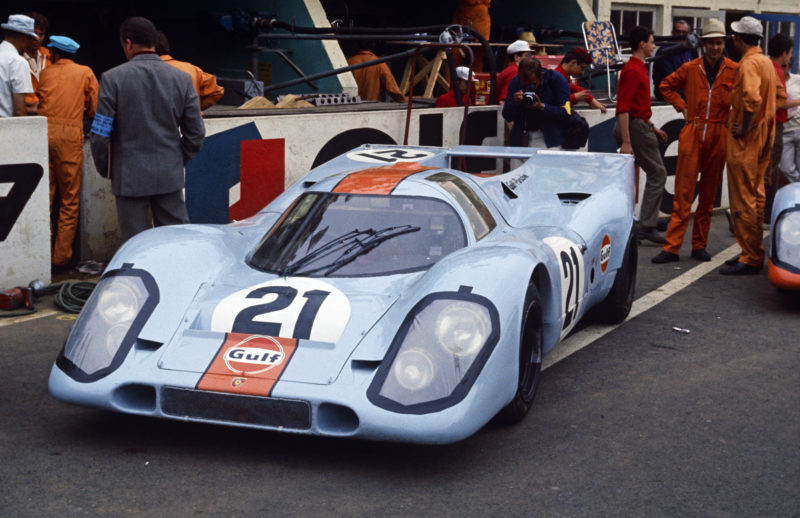
917-016 in the pits before the start of the 1970 24 Hours of Le Mans. Picture credit: Porsche
917-017/004, 917-016 and 917-026 all participated in the 1970 24 Hours of Le Mans and were all painted in the Gulf Oil blue and orange livery, with some variations in the liveries and of course the race number in the meatball. 917-017/004 wore race No. 20 and did not finish. Even though Jo Siffert was leading the race by a large margin, he over-aggressively tried lapping two 917 longtails at the entrance of the Dunlop arch on lap 156 around 1:30 AM in the rain, missed a shift, over-revved the engine and completely destroyed the crankcase. The sound echoed down the pitlane. 917-016 wore race No. 21 and also DNF due to an engine failure on lap 22 with Pedro Rodriguez driving. 917-026 was race No. 22 and gained seven positions in the first three hours of racing, but in the deluge of rain Mike Hailwood spun in the Dunlop curve on lap 49 hitting an already parked Alfa Romeo T33/3. 917-026 can be seen hanging from a crane while being removed from the track in period photos. Any wonder why this was a “tremendous disappointment” for the JW Automotive Engineering team…
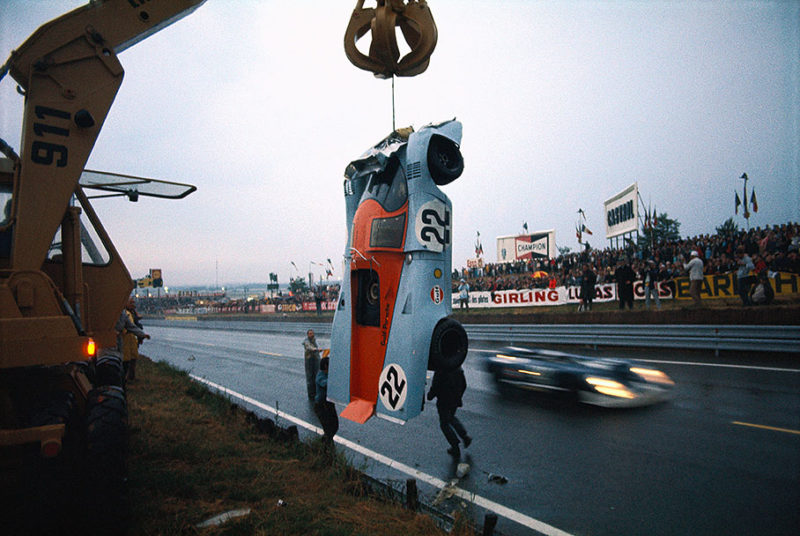
917-026 being removed from the track after spinning in the rain just before nightfall. The car passing is the Solar Production Porsche 908 camera car. Picture credit: Rainer Schlegelmilch
These three chassis not only ran the race, but as mentioned before, they played a major role in the movie “Le Mans”. That’s because Solar Productions (Steve McQueen’s production company that produced “Le Mans”) filmed all angles of the race and even entered a Porsche 908 to run the race with an onboard camera to capture real on track racing footage! Since actual race footage was used in the movie, when you see 917 No. 20 ripping through the Esses during the first few minutes of the race, that’s chassis 917-017/004.
However, a lot of scenes were recreated to help tell the story in the movie. Especially since none of the Gulf Oil liveried machines made it very far into the race and therefore limiting available race footage. This means, when you see Michael Delaney aka Steve McQueen behind the wheel, that’s not 917-017/004 anymore, that’s 917-022.
Chart of the three JW Automotive Engineering 917 at the race:
| Chassis No. | Livery Race No. | Drivers | Result |
| 917-017/004* | 20 | Jo Siffert / Brian Redman | DNF: engine |
| 917-016 | 21 | Pedro Rodríguez / Leo Kinnunen | DNF: engine |
| 917-026** | 22 | Mike Hailwood / David Hobbs | DNF: accident |
*It is reported that 917-004 was originally 917-017, so technically the chassis number is 917-017/004. This renumbering occured because 917-004 crashed at Brands Hatch in April 1970 with Brian Redman behind the wheel. 917-004 was damaged badly enough in the rear that it was easier to swap to a new chassis during the middle of the season instead of waiting for repairs. Therefore 917-017 became 917-004 and vice versa, hence 917-017/004. Renumbering was common in period because it allowed teams to more easily track parts and maintenance, and most importantly retain the same customs booklet (carnet de passage) despite the completely different chassis.
**Similar to 917-017/004, 917-026 was renumbered with chassis 917-031 after the 1970 24 Hours of Le Mans crash. Meaning, 917-026 is now 917-026/031. 917-026/031 is being offered for sale in Monterey this August, 2021 by RM Sotheby’s. RM is listing the chassis number as 917-031/026, however I think it’s better to write chassis numbers with the original number first, then with the current displayed chassis tag.
The Movie
In the 1971 film “Le Mans” there were also three Gulf Oil liveried Porsche 917s, but they were not the same chassis numbers that ran the race. As mentioned before, when it’s actual race footage, then you are seeing the chassis numbers indicated above. However, when you are seeing close ups of the drivers behind the wheel as well as the scenes recreated on track or in the pits or with mounted onboard shots, then you are looking at the following three chassis numbers: 917-013, 917-022 and 917-024-2. How do you tell the difference between race footage and scenes filmed specifically for the movie? One way is to look for the Porsche crest on the nose of all the 917s.
During the 1970 24 Hours of Le Mans 917-017/004 No. 20 not only had the Porsche crest on the nose, but a covered naca duct under the windshield. During filming of the movie 917-022 No. 20 has an open naca duct and didn’t have the Porsche crest. It can even be spotted in scenes without the Gulf Oil decal on the nose. This means if you don’t see the Porsche crest on the nose, then those 917s are the “Le Mans” movie cars. The theory behind this could be that Porsche AG agreed to loan 917s to the production only if they didn’t run the Porsche crest. At least Porsche loaned 917s for the filming (917-042 No. 25 being one of them), unlike Ferrari who refused to loan any cars, therefore forcing the production to source those cars from privateers. A keen eye will also notice there are subtle differences with the shape and thickness of the tape around the headlight lenses. Don’t get me wrong, it’s very difficult to spot any difference in the movie as they blend the real race action and on set scenes very well. Another tell is the fact that during the race it was gloomy and hazy, while during filming of the movie it was mostly sunny, not counting some rainy scenes.
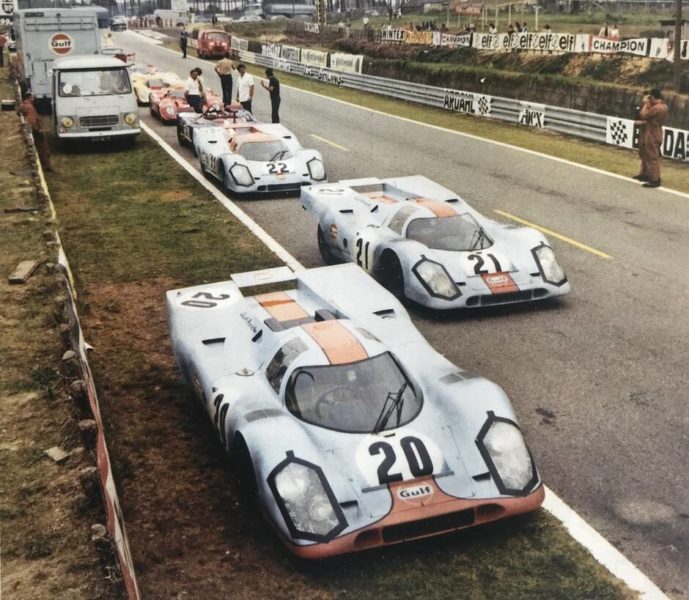
917-013, 917-022 and 917-024-2 staging for a scene on the set of “Le Mans”. Picture credit: Unknown
917-013 was painted in the No. 21 livery and was loaned to Solar Production by JW Automotive Engineering. During filming, real racing driver David Piper crashed and the car was completely destroyed. This means that 917-013’s time onscreen is probably limited. 917-013 was renumbered with chassis 917-034, making it 917-013/034. Because of how badly the original chassis of 917-013 was damaged, it was most likely scrapped. There is a wild photo in Jay Gillotti’s book, “Gulf 917”, of what looks like the entirety of 917-013 stuffed into a Ford Transit. Unfortunately, Mr. Piper had a serious enough injury to be sent to the hospital back in England. While there his leg became infected because the doctor was on vacation and couldn’t see him for a couple of days, resulting in the amputation of his leg below the knee!
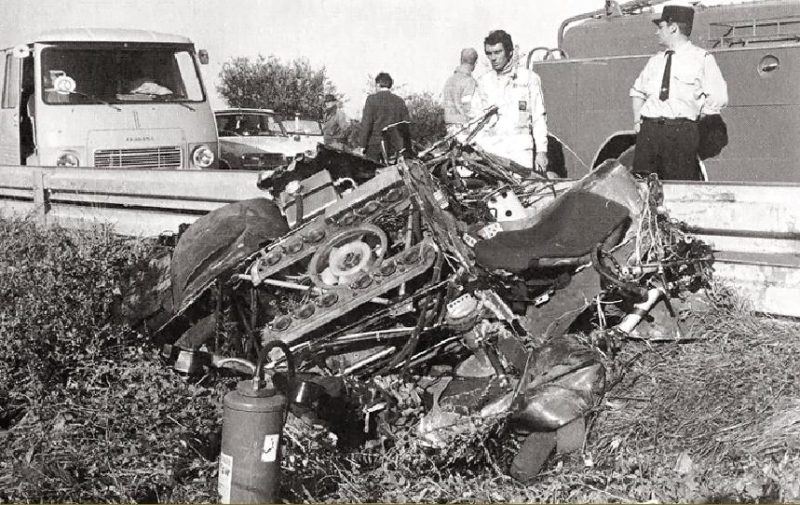
Actor Carlo Cechi looking on. Picture credit: Michael Keyser
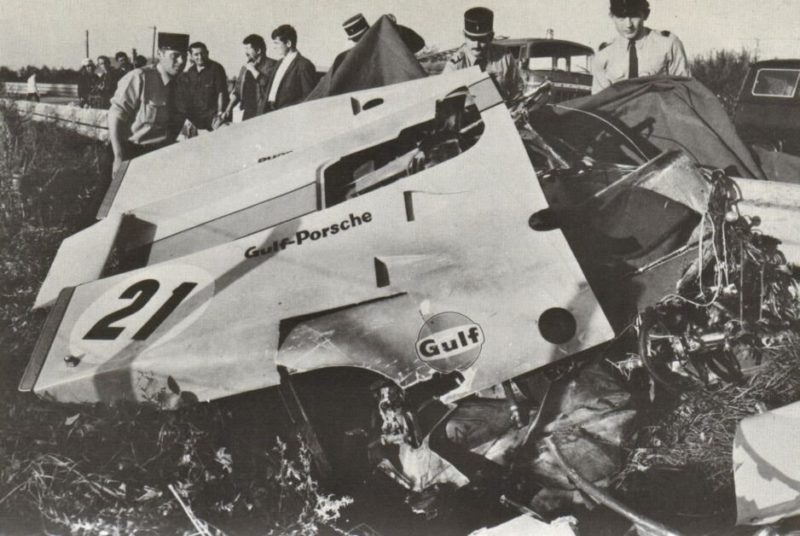
Actor Carlo Cechi looking on. Picture credit: Michael Keyser
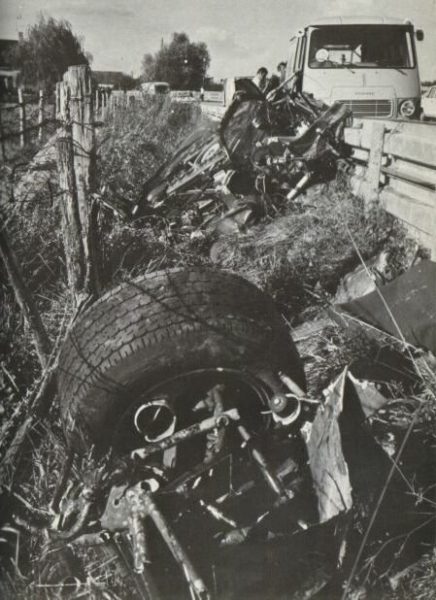
Picture credit: Unknown
Despite this real wreck of 917-013 in the No. 21 livery, this livery continued to be used until the end of the movie on another 917, most likely on 917-022. Details of that below.
Unlike the majority of the other cars used for the movie, chassis 917-022 was not leased, it was purchased directly from Porsche AG by Steve McQueen’s production company, Solar Productions. It seems there was even a plan for Steve McQueen to race 917-022 in the 1970 24 Hours of Le Mans with selected co-driver Sir Jackie Stewart. However, Cinema Center Films (another production company involved) didn’t allow Steve to run the race because of the huge investment at risk if Steve were to get injured or worse…
They did, however, agree to let Steve do his own stunt driving for the film. In the movie Michael Delaney aka Steve McQueen started the race in the 917 No. 20, chassis 917-022, but unfortunately it is scripted that Delaney crashes his car into a guardrail and is knocked out of the race. Luckily, the crash you see in the movie is with a Lola chassis disguised to look like his 917. There are many claims, and even evidence, that 917-022 was painted in the No. 21 livery as mentioned above for filming the remaining scenes for No. 21, since 917-013 was no longer available due to the real wreck on set. Also, there was no longer a need for the No. 20 livery since it had fictionally crashed out of the race. This means when No. 21 comes into the pits for an unscheduled stop and the team manager, Ronald Leigh-Hunt as David Townsend, asks Michael Delaney if “he’s fit” because he wants Michael to finish the drive for Ritter who is “not quick enough”, it’s most likely in chassis 917-022 again. It makes sense for Steve to continue driving the car he owns. Michael Delaney agrees regardless of the dangers and goes on to help beat the Ferrari’s and for Porsche to “win” the race overall!
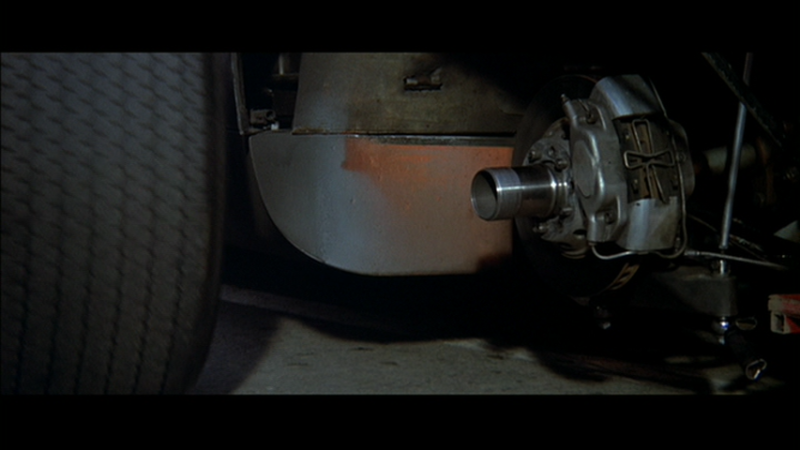
Screen grab from the movie “Le Mans”.
More evidence of this livery change for 917-022: If you notice at 1 hour and 25 minutes into the movie, No. 21 enters the pits for the unscheduled stop mentioned above and the team realizes they have an issue with the left rear suspension. A broken lower control arm or as the team says, “wishbone”. At this time they remove the rear wheel and you can see from the screen grab above that the paint on the leading inner fender is not fully painted blue. There are hints of a swath of orange and a black stripe. This points to this 917 previously having been in livery No. 20, the only Gulf Oil livery at Le Mans in 1970 or on set which had the orange and black stripe on this lower portion of the car. So other than various claims, this is actual evidence that chassis 917-022 changed from livery No. 20 to No. 21.
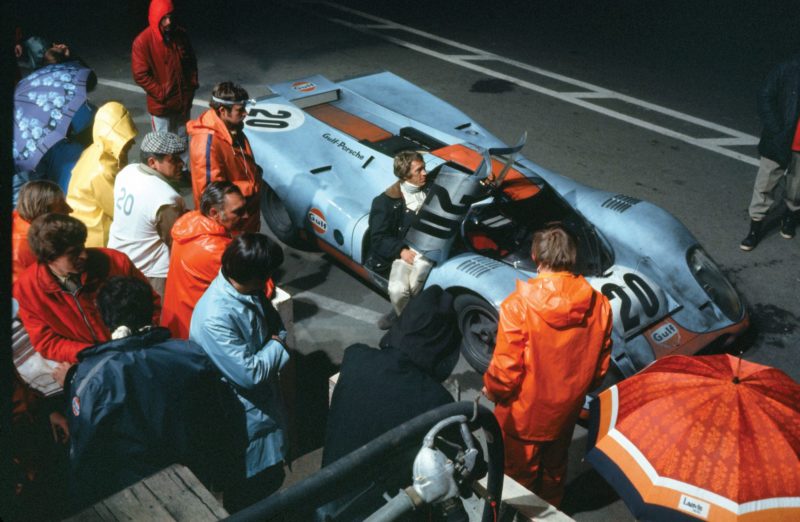
Steve McQueen sitting on the driver’s side of 917-022 on set of the movie “Le Mans”. Picture credit: Unknown
Even more evidence that this livery change occurred for 917-022: After the filming, German racing driver Willi Kauhsen purchased 917-022 and entered it in the 1971 Buenos Aires 1000 km in Argentina with co-driver Reinhold Joest. There are reports that it arrived in the Gulf Oil livery No. 21 before new sponsor decals were added and it included a note from Steve McQueen and his signature on the door. The note said, “Finished – Thanks for staying together – Steve McQueen”. Today this car sits unrestored back in the original No. 20 Gulf Oil livery in the Seinfeld Collection.
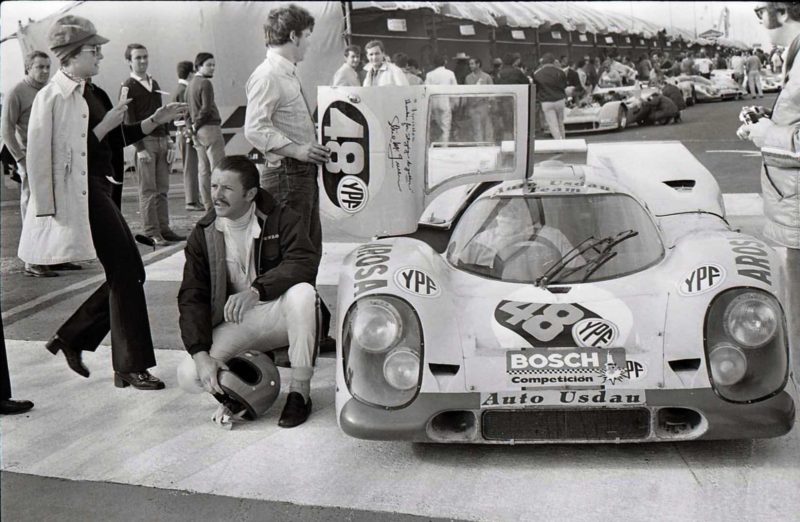
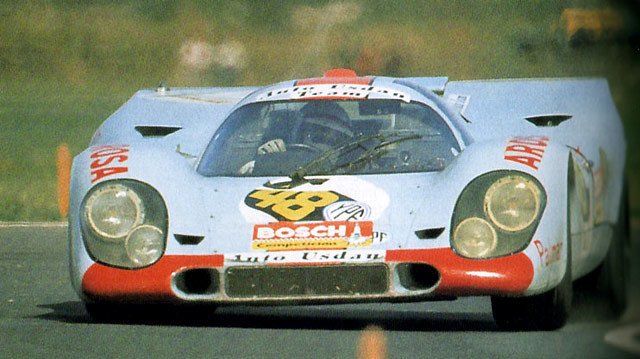
Pictures of 917-022 in a stickered over Gulf Oil livery with the note from Steve McQueen. Picture credit: Unknown
917-024-2 was in the No. 22 livery and was leased to the film production by racing driver Jo Siffert along with several other cars. It’s claim to fame from the movie is that it beat the Ferrari’s and won the race overall with Christopher Waite as Larry Wilson driving! There are claims that 917-024-2 was also painted in other liveries for the making of the movie. Possibly at times in the Gulf Oil No. 21 livery and also to represent chassis 917-021 in the Racing Team AAW yellow SANDEMAN sponsored No. 18 livery. However, this can’t be 100% confirmed. The history of 917-024-2 is complicated, but according to the late Walter Näher (a 917 race engineer and the author of the Porsche Museum’s 917 book) there were actually two 917-024 chassis built. The first being renumbered multiple times and the second completely new. 917-024-2 is the second and the one being mentioned above. After the filming and back in Siffert’s possession, the livery at that time looked similar to what the No. 20 livery would be, but with a No. 1 in the meatball. Siffert drove 917-024-2 to his birthday celebration on July 7, 1971, and sadly, this car, with no racing number, was also used to lead the funeral procession following his death on October 24, 1971. Today this car has been restored once with a new frame and a second time with parts of the original. It was pulled from auction in 2014 and later sold at Gooding and Company in 2017. Today it can be viewed at the Brumos Collection in Jacksonville, Florida.
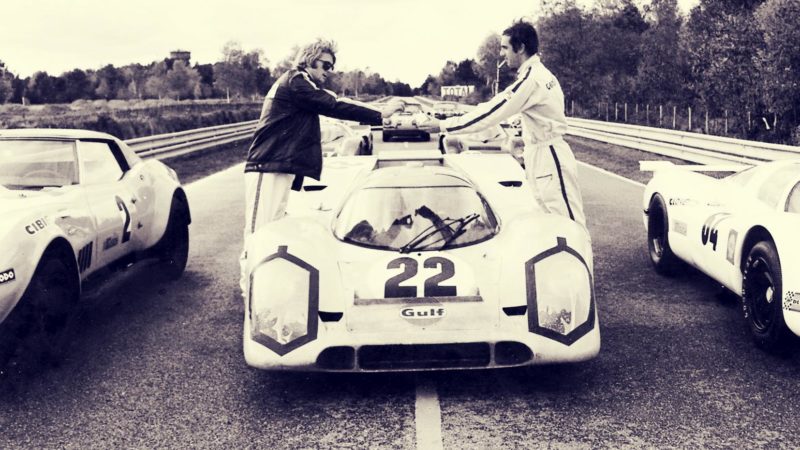
Steve McQueen reaches for a cigarette over 917-024-2 on set of the movie “Le Mans”. Picture credit: Unknown
Chart of the Gulf Oil liveried 917 for the movie:
| Chassis No. | Movie Livery No. | “Drivers” | “Result” |
| 917-022 | 20 | Steve McQueen as Michael Delaney / Co-driver unknown | “crashed” |
| 917-013 | 21
At first 917-013 was No. 21, then 917-022 and possibly 917-024-2 as well. |
Fred Haltiner as Johann Ritter / Peter Parten as Peter Wiese
Also, Steve McQueen as Michael Delaney replacing Johann Ritter and Fred Haltiner |
2nd OA |
| 917-024-2 | 22 | Christopher Waite as Larry Wilson / Jean-Claude Bercq as Paul-Jacques Dion | 1st OA |
